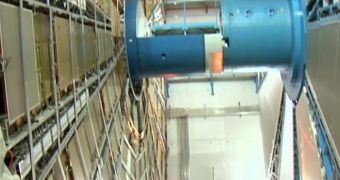If you were ever interested in learning how the Large Hadron Collider actually works, this is your chance. The video above shows how the ATLAS (A Toroidal LHC Apparatus) instrument on the world's largest particle accelerator works.
The LHC was built primarily to detect the Higgs boson, a subatomic particle that is believed to allow energy to acquire mass. In addition, it studies the nature of antimatter and dark matter, and is involved in refining existing knowledge of other rare subatomic particles as well.
In the video, University of Nottingham expert Tony Padilla explains the basic operating principle behind ATLAS, which is one of the three primary collision sites on the hadron collider. The scale of the experiment is revealed by establishing shots filmed from underneath the proton beam tunnels.
Padilla also explains the basics of how photons, muons and the Higgs boson are detected inside the giant camera. Several links continuing the tour through the LHC are available at the end of the video. Enjoy!

 14 DAY TRIAL //
14 DAY TRIAL //